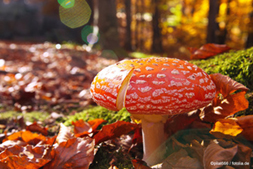Danger of poisoning from gathering mushrooms

The mushroom season has begun - and so also the time for mushroom poisoning. Effects range from nausea to fatal organ failure.
For some years, a growing number of people have been gathering mushrooms in the forests around Freiburg and throughout Baden-Wuerttemberg, armed with mushroom lexicons and baskets. Besides the porcino and morel, over 600 other species are represented in the Black Forest around Freiburg. However, many poisonous mushrooms look confusingly similar to edible ones. The uninitiated cannot distinguish between most types of mushrooms. "It is not sufficient to go into the forest with a mushroom book," says Dr. Maren Hermanns-Clausen, head of the Poisoning Information Center at the Medical Center - University of Freiburg. "Because how mushrooms look can be vary a lot, if one does not know exactly which markings to watch out for."
If in doubt, collectors should ask mushroom instructors or experts, and keep their fingers off unfamiliar mushrooms. But even mushrooms from the supermarket can cause poisoning if stored incorrectly. If mushrooms are stored for a long time in the heat, they start to decompose. The result is food poisoning.
Around 240 mushroom poisoning inquiries are received annually by the experts of the Poisoning Information Center at the Medical Center - University of Freiburg. Around three cases a year are life-threatening.
What to do if children eat unknown mushrooms?
More than half of the mushroom poisoning inquiries are made to the Poisoning Information Center Freiburg by concerned parents, whose children have tasted an unknown mushroom. "Fortunately, children usually eat very few mushrooms, which rarely has serious consequences," says Dr. Hermanns-Clausen. "Through our advice, in these mild cases, we can usually spare the children a hospital stay." It is important to save any mushroom remnants, to be able to describe them precisely later. The employees of the Poisoning Information Center Freiburg can usually already determine by telephone whether a dangerous mushroom is involved. "The more precisely the mushroom can be described, the more accurate the necessary treatment can then be," explains Dr. Hermanns-Clausen.
Symptoms usually 15 minutes to a few days after mushroom consumption.
Mild mushroom poisoning is often associated with abdominal pain, nausea, vomiting and diarrhea. These symptoms, which are not life-threatening, can occur between 15 minutes and four hours after mushroom eating, and last for several days.
Severe or life-threatening poisoning can lead to kidney or liver failure. In rare cases the indications - such as lateral abdominal pains, muscle pains or bloody urine - appear only days afterward. "Often these symptoms are then no longer associated with the mushroom consumption," says Dr. Hermanns-Clausen. In severe cases, only an organ transplant can save the patient.
In case of clear poisoning symptoms, children and adults should go to a doctor or hospital as soon as possible. If poisoning is treated quickly, patients will usually completely recover.
General tips for emergencies:
1. Keep calm and do not take any hasty measures, in particular
• do not give salt water
• do not give milk
• do not induce vomiting
2. When calling a Poisoning Information Center, the following information is important:
• Who (age and weight of victim) ate
• What (description of mushroom)
• When (exact time of consumption)
• What amount (exact amount and/or maximum possible amount)
• What has been done so far?
• How is the patient?
• How can the caller be reached? (phone number)
3. Call a doctor if necessary
4. Give a few sips to drink (water, tea or juice, but no milk)
5. Following contact with eye contact or skin, flush with water
Back